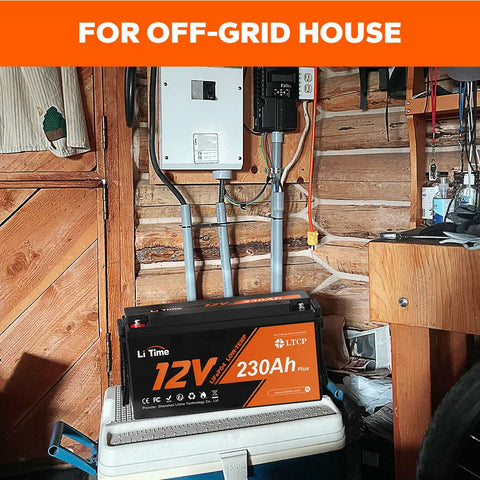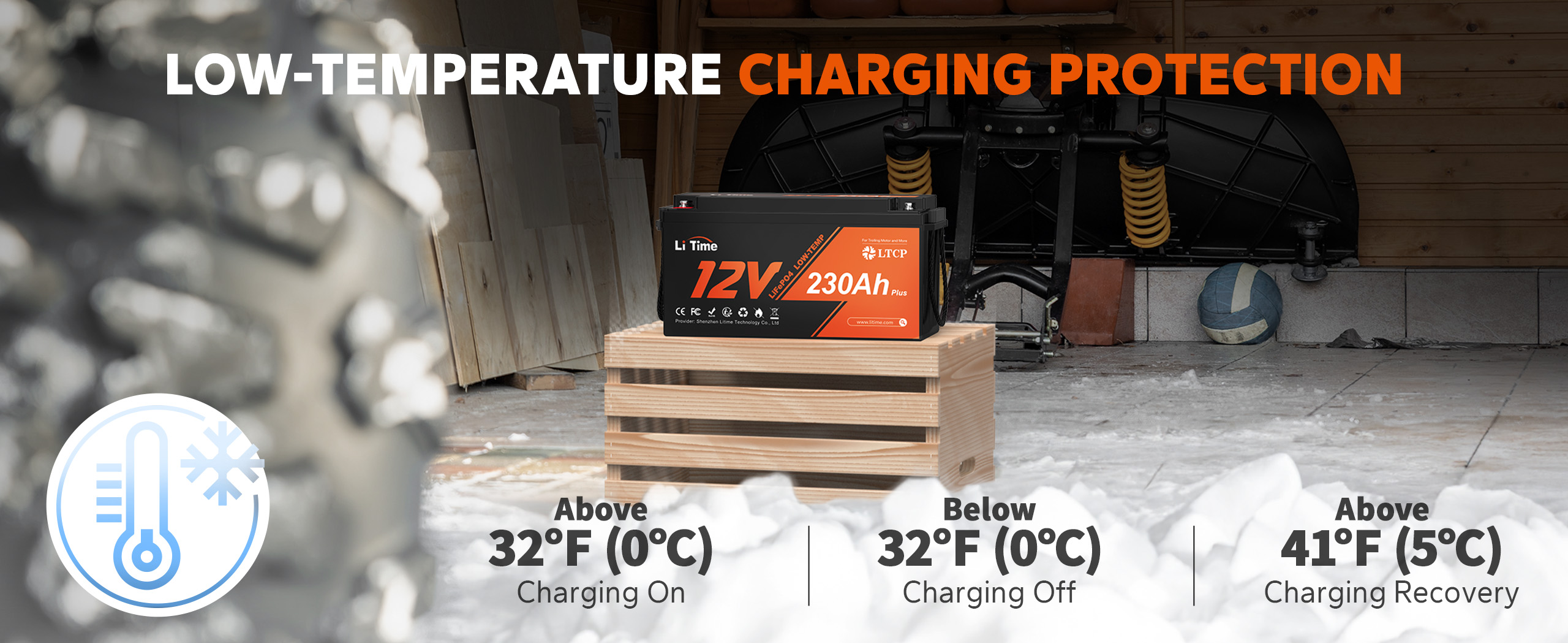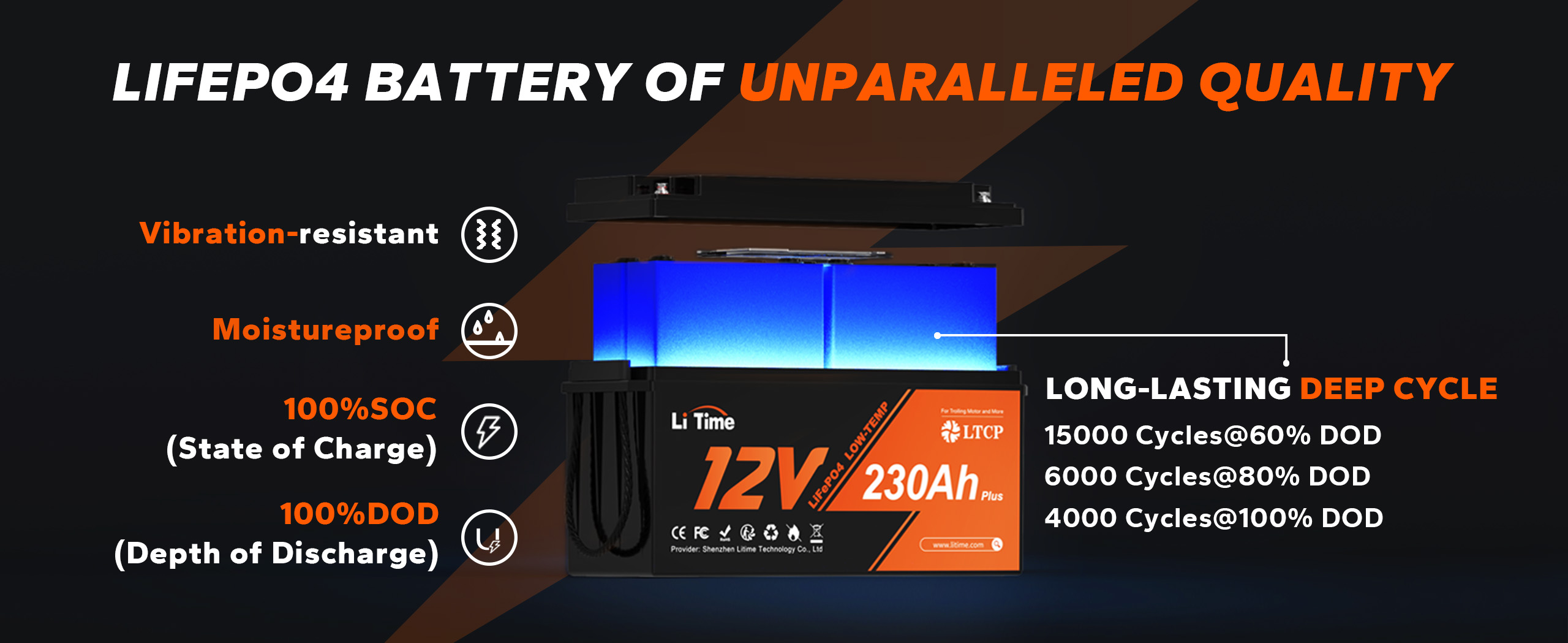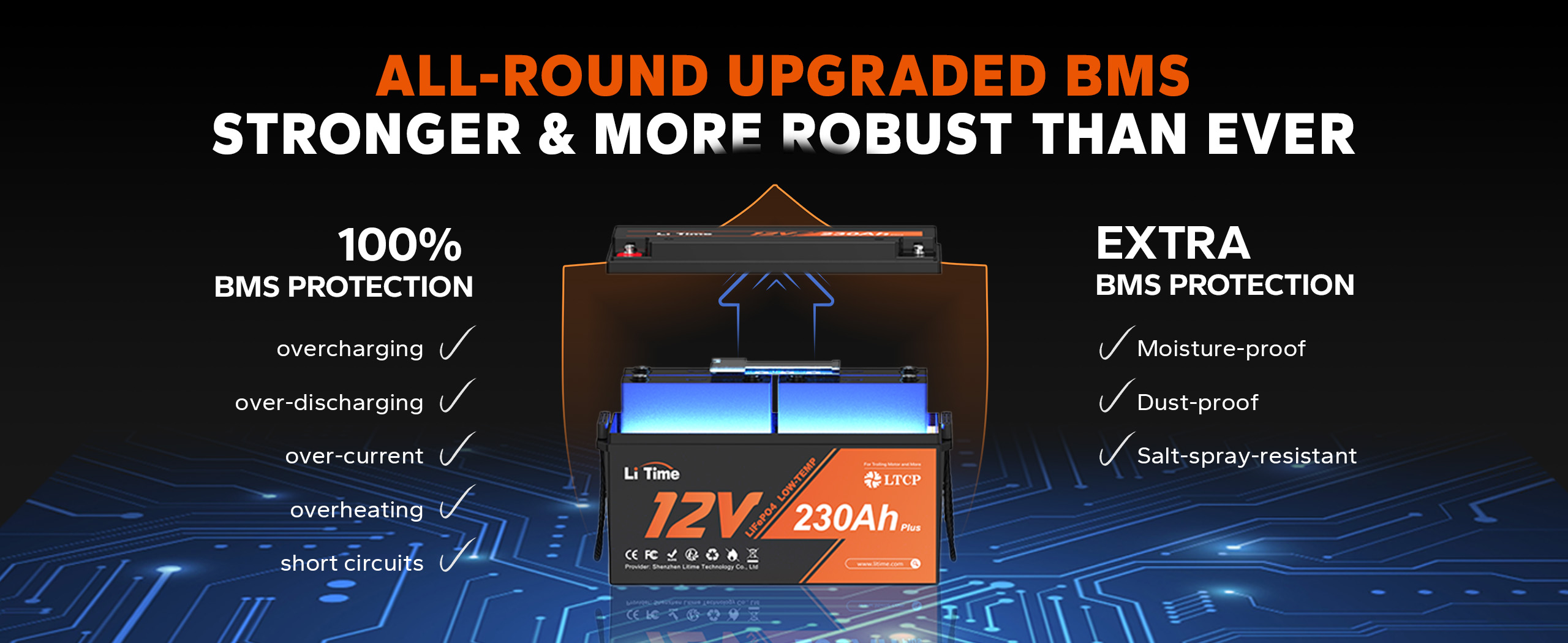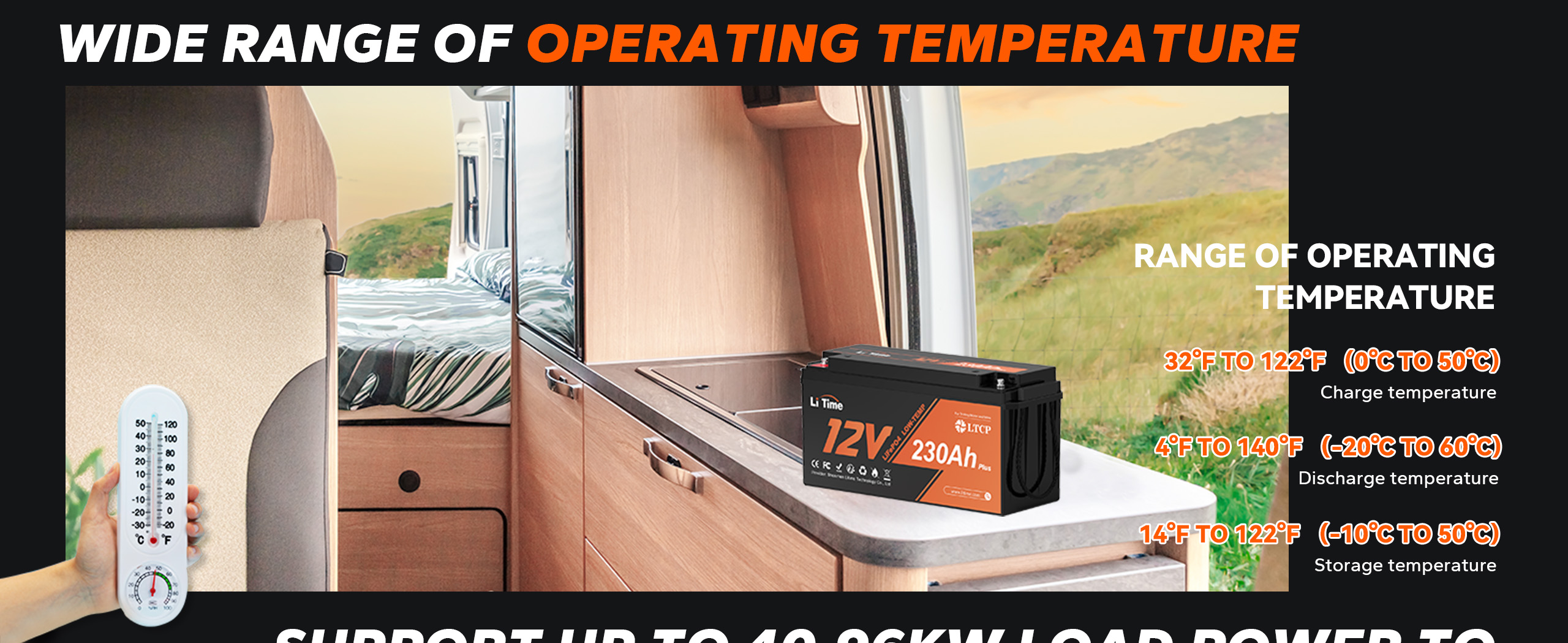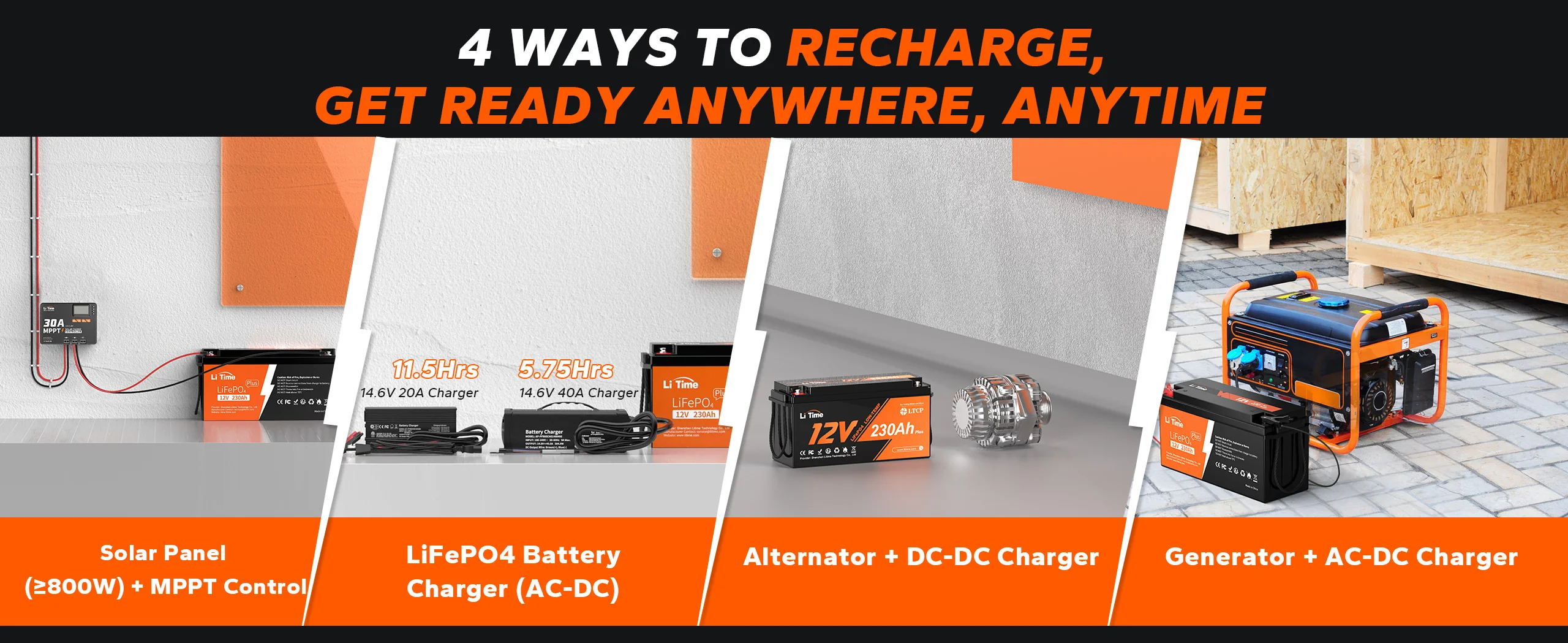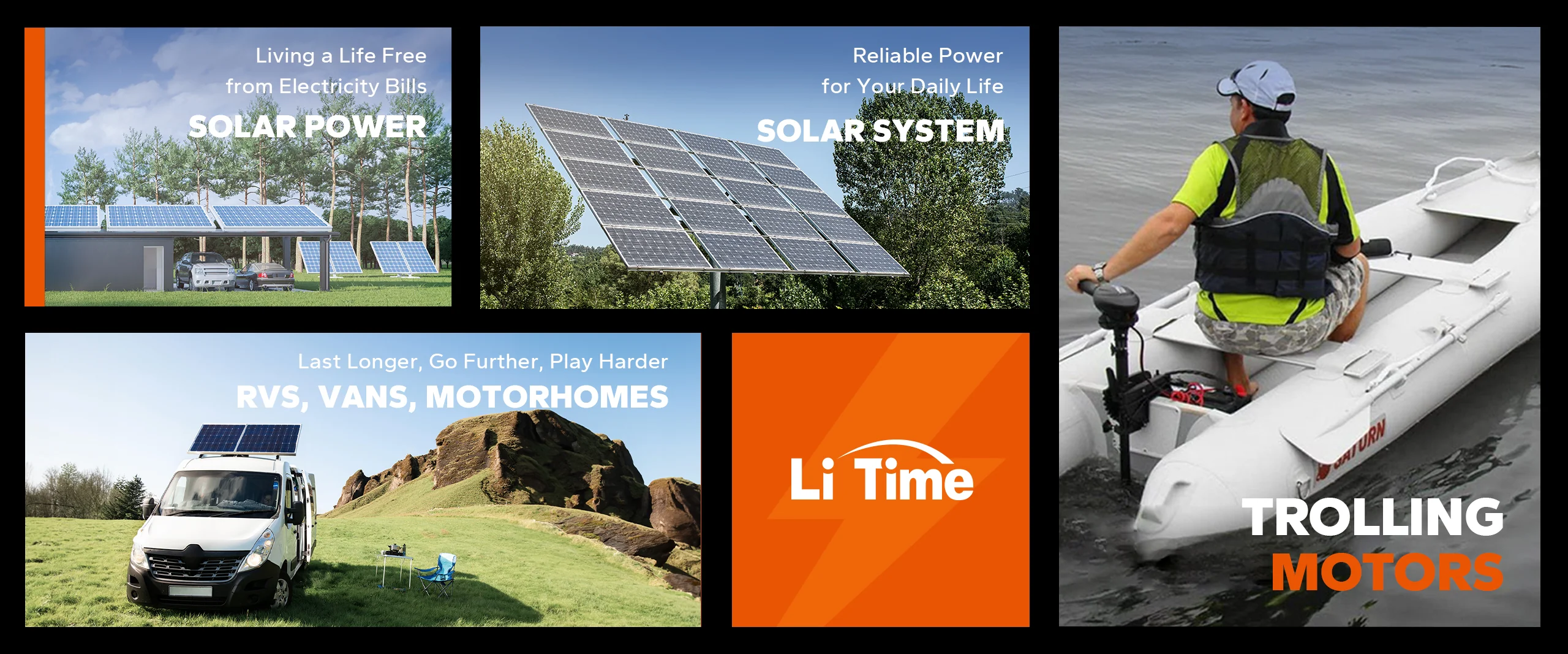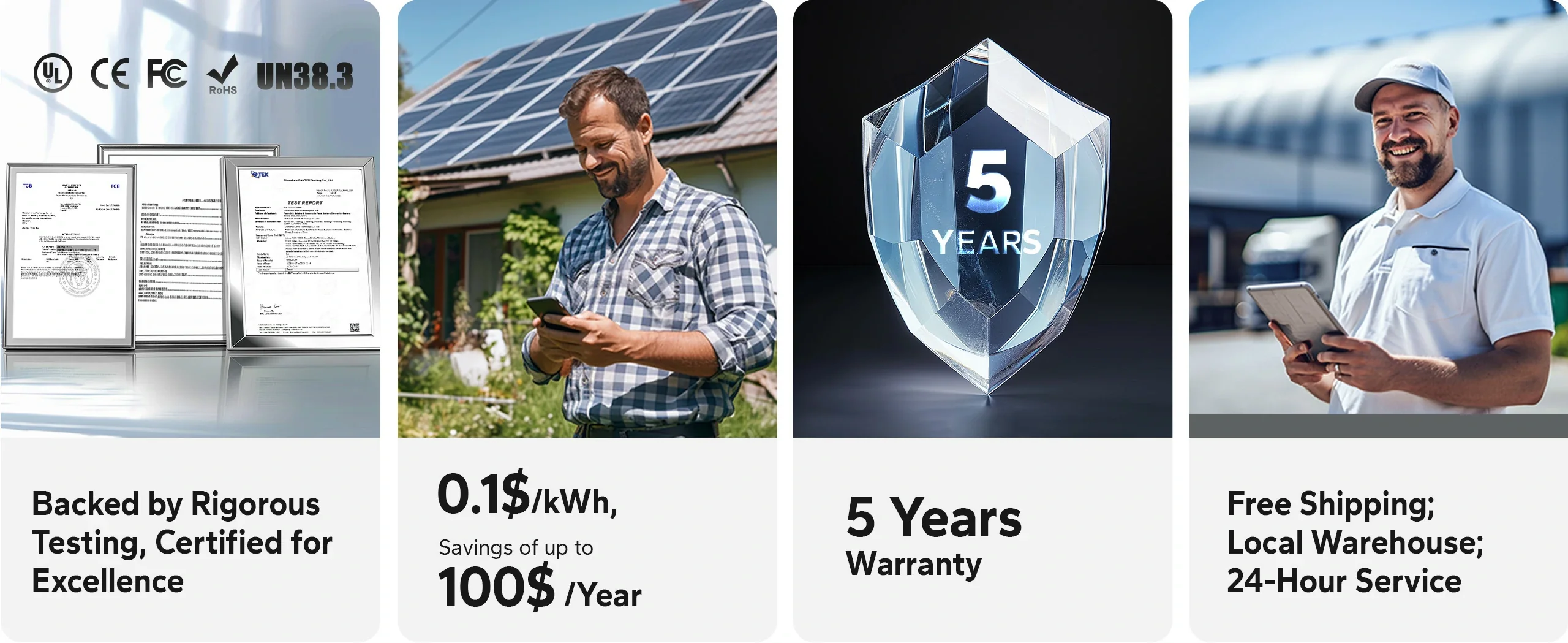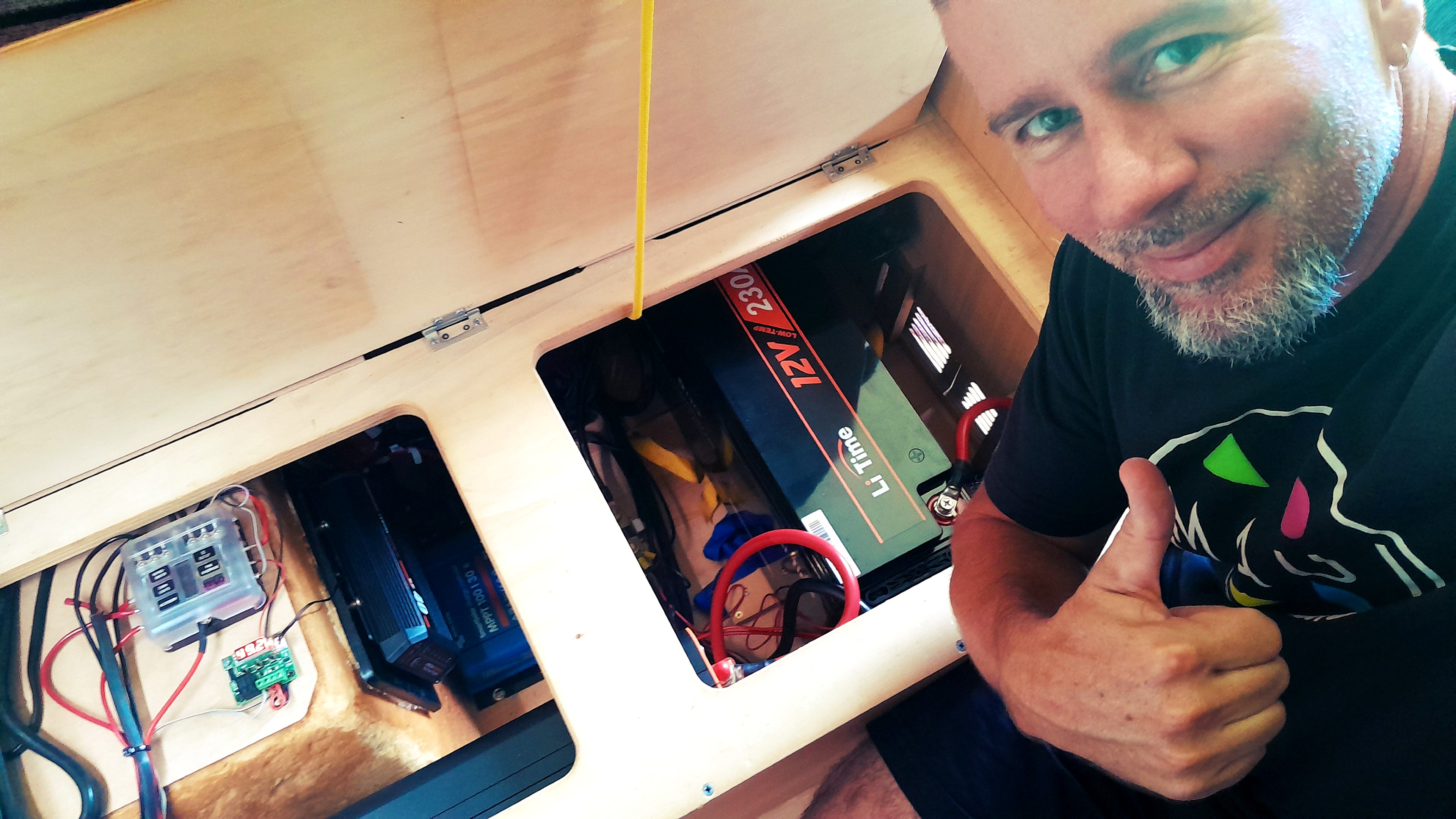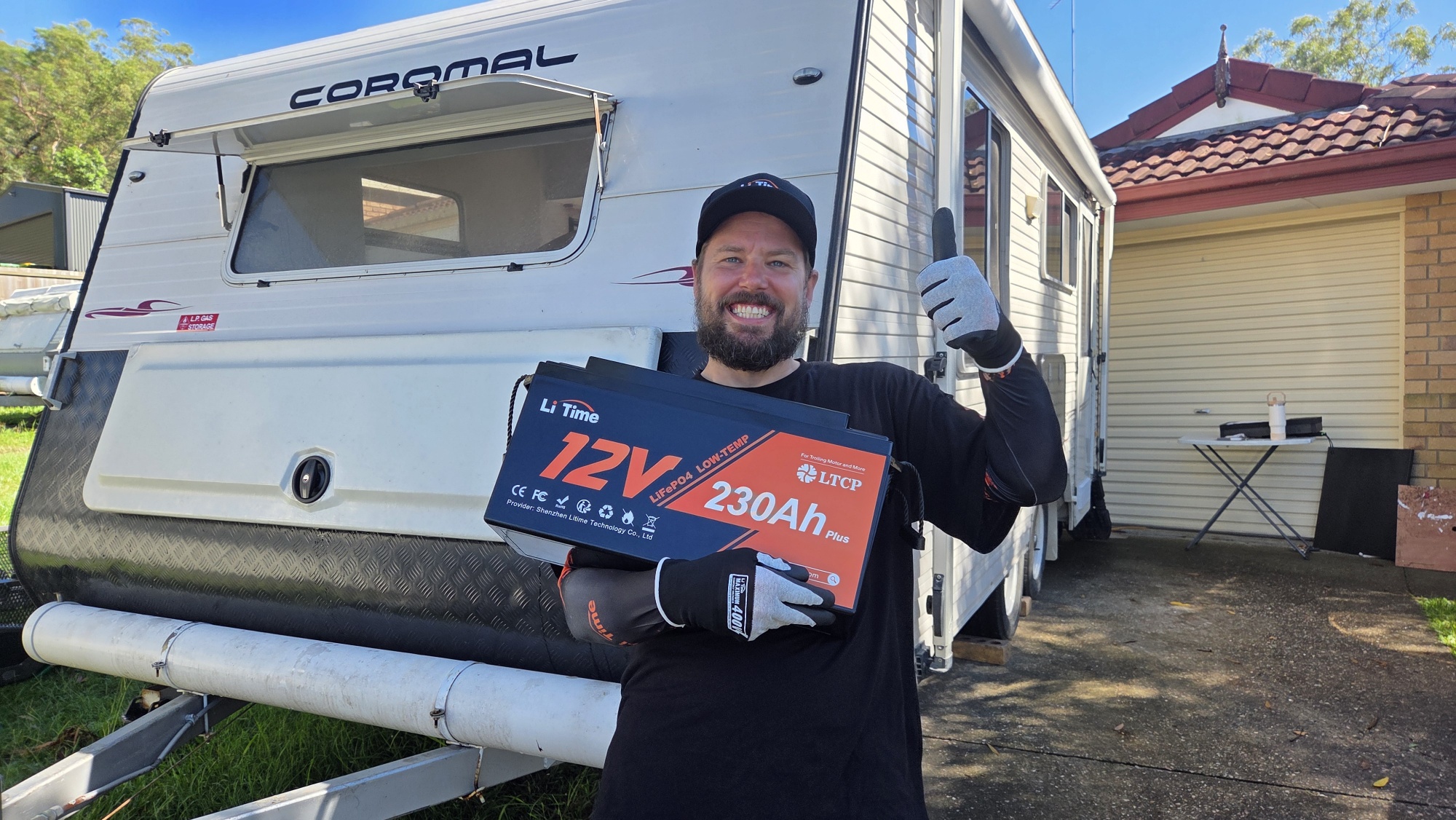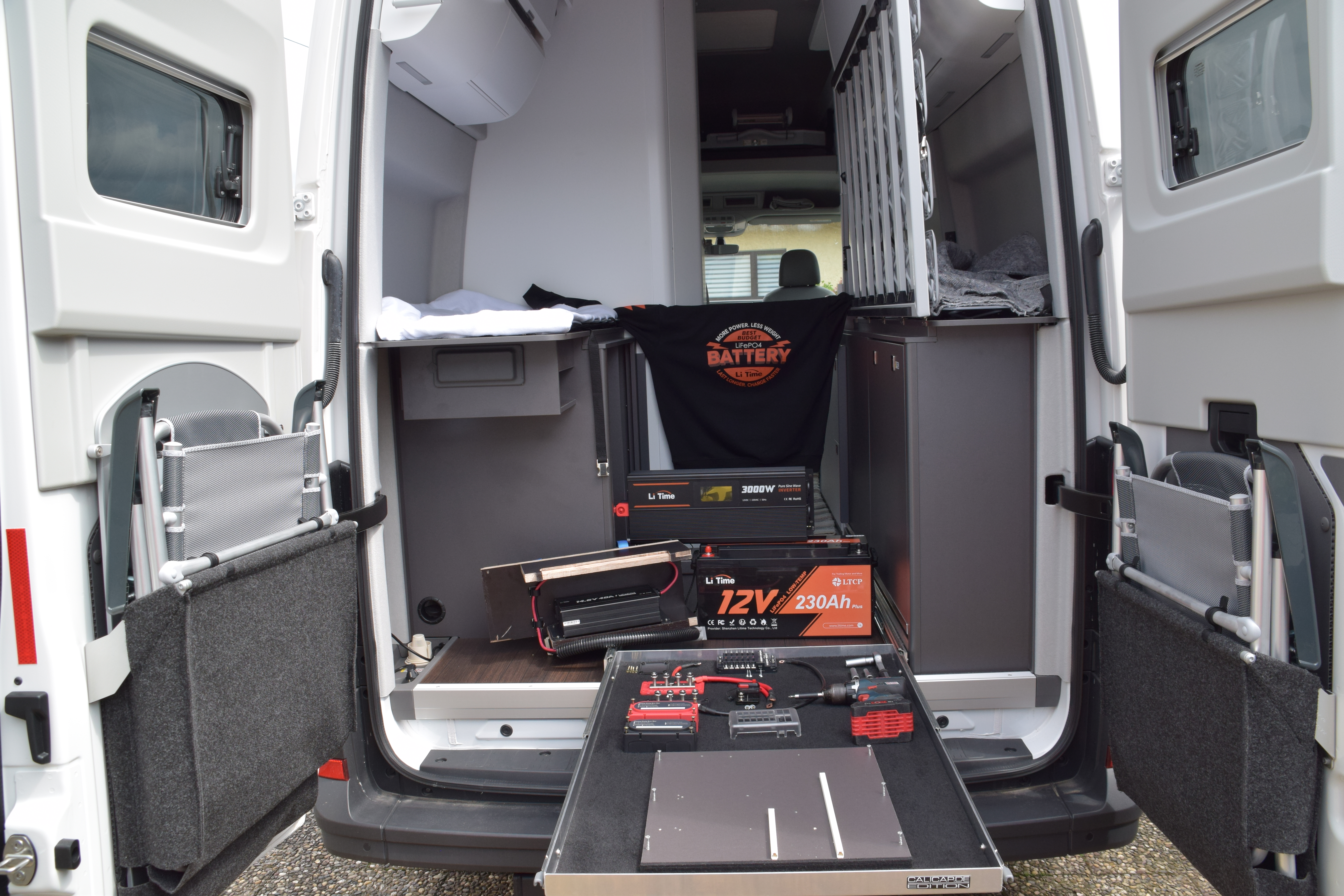LiTime 12V 230Ah Plus Deep Cycle LiFePO4 Battery with Low-Temp Protection
 Will Prowse "Best Value" 12V LiFePO4 Battery for 2023
Will Prowse "Best Value" 12V LiFePO4 Battery for 2023
- Ideal for marine, RVs, UPS, and backup power.
- Low-temp protection, 32℉ charging off, -4℉ discharging off, and 41℉ charging resume.
- 200A BMS, with 200A max. continuous discharge current.
- 20+ Upgraded protections, with auto-recovery(30s) after overload protection, resistance of moisture & salt-spray, pre-charge function.
- EV-graded LiFePO4 cells, 4000+ cycles@100% DOD, 10 years lifespan, non-toxic.
- 2944Wh & 2560W, enough to power approx. 3kWh of daily home/off-grid or use of RV/fishing/camping.
- Max. 4P4S, up to a 51.2V 920Ah battery system (47.10kWh & 40.96kW).
- 6X energy density (65Wh/lbs) & 65% lighter than a 12V 200Ah lead-acid battery.
- 4 Charging ways-LiFePO4 Charger, solar panel, alternator, generator.
- Size: L19*W6.7*H9.5 inch. View Specs.
- UL-1973 tested, FCC, CE, RoHS, UN38.3 certified.
- Meets ABYC E-13 Standard: LiTime batteries are installed to ABYC E-13 standards, fully compliant with lithium battery requirements.
- DO NOT use as Starter Battery. If you need a starting battery, please consider LiTime 12V marine starting batteries series.
- Please do not orient the battery on top or front side downward. Other orientations are permissible.
- $479.99
-
$849.99 - $479.99
- Unit price
- per
Please hurry! Only 95 left in stock
Subtotal:
$479.99
Couldn't load pickup availability
Free Shipping
Free standard shipping on all orders
Estimated to be delivered within 2-5 business days.
5 Years Warranty
Backed up by techical support within 24hrs.
Free Returns
30 Days Hassle Free
Returns
Frequently Bought Together
-
FEATURES
-
SPECS
-
FAQ
-
REVIEWS
Upgraded Low-Temperature Cut-Off Protection
Maximize your battery life and charging efficiency with the low-temperature cut-off protection - keeping you safe and powered up even in the coldest conditions. LiTime 12V 230Ah low-temp cut-off protection battery can cut charging when it is below 0°C/32°F and disconnect loads when it is below -20°C/-4°F to extend our battery life. While other batteries struggle in chilly conditions, suffering capacity loss or going into hibernation, our advanced technology safeguards your charge and discharging.
Ultra-Long Battery Lifespan
Most lead-acid batteries are only 2~3 years lifespan. But the LiTime LiFePO4 battery is built to stand the test of time. Boasting a stunning 4000+ cycles@100% DOD, the LiTime lithium battery leads the industry in sheer longevity. That allows you to power your home or cabin for over a decade. Experience peace of mind with EV Grade-A LiFePO4 battery cells, which are free from mercury, lead, and other toxic substances. IP65 waterproof level protect against water and dust.
All-Round Upgraded BMS
The upgraded 12V 230Ah LiFePO4 deep cycle battery is designed for harsh environments such as rainy, coastal areas, or dusty and wet conditions, and offers worry-free and long-lasting performance with a reduced risk of damage and an extended lifespan. Our upgraded BMS secures your battery from over-charging, over-discharging, and short-circuiting, ensuring a safer and more reliable battery. You can reduce the cost of replacing vulnerable batteries.
Max. 4P4S, Up to 47.104kWh of Energy
Experience unparalleled versatility with the LiTime 12V 230Ah low-temp protection lithium batteries. Combine up to 16 units with a 4P4S configuration to establish a formidable 51.2V 920Ah system, boasting a staggering 47.104kWh of green energy. Tailor your energy solution to suit your needs, whether it's for residential, marine, RVs, trolling motors, off-grid, or any scenario demanding extended runtime capabilities or in any cold conditions. With LiTime, the possibilities are endless.
4 Ways to Recharge
The LiTime 12V 230Ah low-temp cut-off protection lithium battery outperforms lead-acid batteries with its faster charging efficiency. Moreover, there are 4 versatile charging options: LiFePO4 chargers, solar panels, alternator and generators. It takes about 5.75 hours to fully charge the battery with a 14.6V 40A LiFePO4 charger, enabling you to swiftly recharge the battery for a better user experience.
Conquer Every Scenario with Ease
Versatility meets reliability with this battery. LiTime 12V 230Ah low-temp cut-off protection lithium battery is perfect for many applications, including trolling motors, home energy storage, solar power systems, caravans, and outdoor adventures. Its lightweight and compact design allows for effortless portability.
Outstanding Service
Professional technical support, customer service, easy-to-understand operation manuals, phone support, and 24-hour quick online feedback are provided.
Trusted Power for Every Journey
SPECS
BATTERY
Cell Type:
LiFePO4 Prismatic
Warranty:
5 Years
Cycle Life:
4000 cycles at 100% DOD, 6000 cycles at 80% DOD, 15,000 cycles at 60% DOD
Nominal Voltage:
12.8V
Rated Capacity:
230Ah
Energy:
2944Wh
Max. Expansion (Parallel & Series):
4P4S
Internal Resistance:
≤40mΩ
Certifications:
UL, FCC, CE, RoHS, UN38.3
BMS
BMS:
200A
Max. Continuous Output Power:
2560W
Max. Continuous Charge Current:
200A
Max. Continuous Discharge Current:
200A
Max. Discharge Current 5 Seconds:
600A
CHARGE
Charge Method:
CC/CV
Charge Voltage:
14.4V ± 0.2V
Recommend Charge Current:
46A (0.2C)
TEMPERATURE
Charge Temperature:
0℃ to 50℃ / 32℉ to 122℉
Discharge Temperature:
-20℃ to 60℃ / -4℉ to 140℉
Storage Temperature:
-10℃ to 50℃ / 14℉ to 122℉
Low-Temperature Protection:
Yes (32℉/0℃)
Low-Temperature Charging Protection Auto Recovery:
Yes (41℉/5℃)
OTHERS
Terminals:
M8 bolts
Weight Approx.:
45.22 lbs
Size:
L19*W6.7*H9.5 inch
Housing Material:
ABS
Protection Class:
IP65
FAQ
Q: Can I use LiTime 12V 230Ah LiFePO4 batteries as starting batteries?
A:
No. LiTime 12V 230Ah lithium batteries are not intended to be used as starting batteries but energy storage, please do not use them to start any devices. Visit LiTime Marine Starting Batteries for starting using.
Learn more about Deep Cycle VS Starting Batteries.
Q: Can I charge LiTime 12V 230Ah LiFePO4 lithium batteries with solar panels?
A:
Yes, you can charge LiTime 230Ah lithium batteries with solar panels. Here are 3 ways to charge the battery.
1. Using Solar Panels
The LiTime 12V 230Ah battery can be fully charged by in one day (with effective sunshine 4.5hrs/day) by 800W solar panels. It may take more than one day to fully charge the battery by ≥800W solar panels since the duration and intensity of light would be a great factor for their charging efficiency.
2. Generator/Alternator
If the alternator or generator supports DC output, a DC-to-DC charger is needed to connect the battery to the generator; if your alternator or generator supports AC output, please add a suitable battery charger to connect the battery and the generator according to our recommendations.
The Recommended Charging Voltage: 14.2V - 14.6V.
The Recommended Charging Current: ① 46A (0.2C): the battery will be fully charged in around 5 hrs to 100% capacity; ② 115A (0.5C): the battery will be fully charged in around 2 hrs to around 97% capacity.
3. LiFePO4 Smart Chargers
To charge 12V battery, it is recommended to use 14.6V battery charger. The Recommended Charging Voltage: 14.2V - 14.6V.
The Recommended Charging Current: ① 46A (0.2C): the battery will be fully charged in around 5 hrs to 100% capacity; ② 115A (0.5C): the battery will be fully charged in around 2 hrs to around 97% capacity.
Rlated reading: Best Ways to Charge LiFePO4 Lithium Battery
Q: Can I charge LiTime 12V 230Ah lithium batteries in cold weather (under freezing temperatures)?
A:
LiFePO4 batteries can safely charge between 0℃ to 50℃ / 32℉ to 122℉. LiTime 12V 230Ah LiFePO4 batteries include the low-temperature charging protection which will automatically cut the battery charging off when the cell temperature is lower than 32℉, thus preventing the battery cells from damage when charging under the freezing point.
Recommended reading on LiFePO4 Temperature Range Guide for more information on safe usage and performance.
Q: How do I store LiTime 12V 230Ah LiFePO4 lithium batteries?
A:
It is recommended to store LiFePO4 lithium batteries at 50% state of charge (SOC). If the batteries are stored for long periods, cycle the batteries at least every 3 months. Recommended storage environment: 10℃ to 35 ℃ / 50℉ to 95 ℉,45%RH~75%RH
Q: In what applications can I use 12V 230Ah LiFePO4 lithium battery?
A:
1. Solar Energy Storage: LiFePO4 batteries are commonly used in off-grid solar energy systems for storing and utilizing solar-generated electricity.
2. RVs and Marine Applications: These batteries are suitable for powering lights, appliances, and electronic devices in RVs, boats, and yachts, providing a reliable and long-lasting power source.
3. Off-Grid Power Solutions: LiFePO4 batteries can be used for off-grid cabins, cottages, or remote locations where a reliable power supply is necessary.
4. Backup Power for Home and Business: They can be utilized as a backup power source for homes, businesses, or critical systems in case of power outages.
5. UPS (Uninterruptible Power Supply): LiFePO4 batteries can be integrated into UPS systems to provide reliable and long-lasting backup power for critical equipment.
Q: How Long Will a 12V 230Ah Battery Last?
A:
The length of time a 12V 230Ah battery will last depends on the amount of current drawn from it and the specific use. You can estimate this by using the following formula:
Battery life (in hours) = Battery capacity (in amp-hours) / Load current (in amperes)
For example, if we assume a load current of 10 amperes:
Battery life = 230Ah / 10A = 23 hours
This means you can expect approximately 23 hours of continuous operation with a 10-ampere load. However, actual duration can vary based on factors such as system efficiency, changes in the load current, and the overall condition of the battery.
Q: Can I pair a Bluetooth Module for this battery to monitor the battery status on the phone?
A:
No. This battery is not compatible with the Bluetooth module. You can use a 500A Battery Monitor With Shunt to keep track of battery status.
REVIEWS
Related Products
LiTime
Example product title
- From $479.99
-
$849.99 - From $479.99
- Unit price
- per
LiTime
Example product title
- From $479.99
-
$849.99 - From $479.99
- Unit price
- per
LiTime
Example product title
- From $479.99
-
$849.99 - From $479.99
- Unit price
- per
LiTime
Example product title
- From $479.99
-
$849.99 - From $479.99
- Unit price
- per
LiTime
Example product title
- From $479.99
-
$849.99 - From $479.99
- Unit price
- per
LiTime
Example product title
- From $479.99
-
$849.99 - From $479.99
- Unit price
- per
LiTime
Example product title
- From $479.99
-
$849.99 - From $479.99
- Unit price
- per
LiTime
Example product title
- From $479.99
-
$849.99 - From $479.99
- Unit price
- per
LiTime
Example product title
- From $479.99
-
$849.99 - From $479.99
- Unit price
- per
LiTime
Example product title
- From $479.99
-
$849.99 - From $479.99
- Unit price
- per
- Choosing a selection results in a full page refresh.

















































































































































